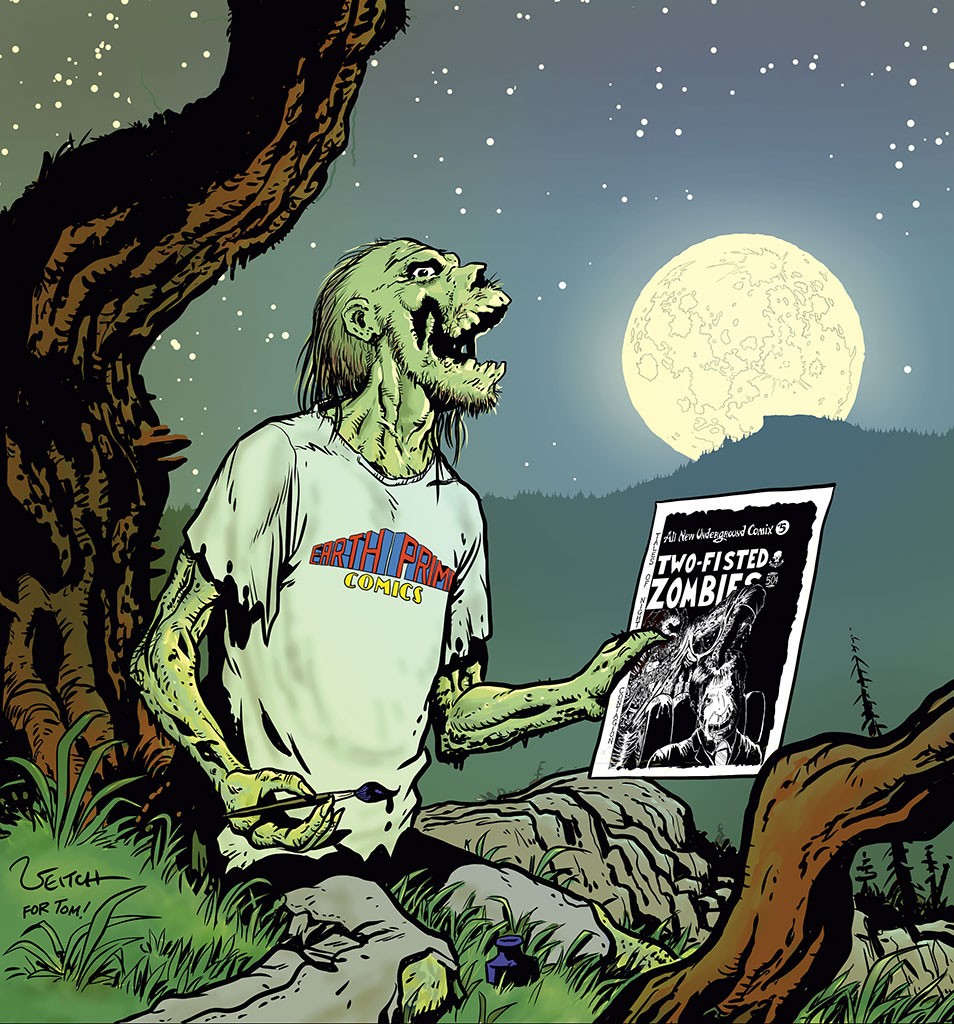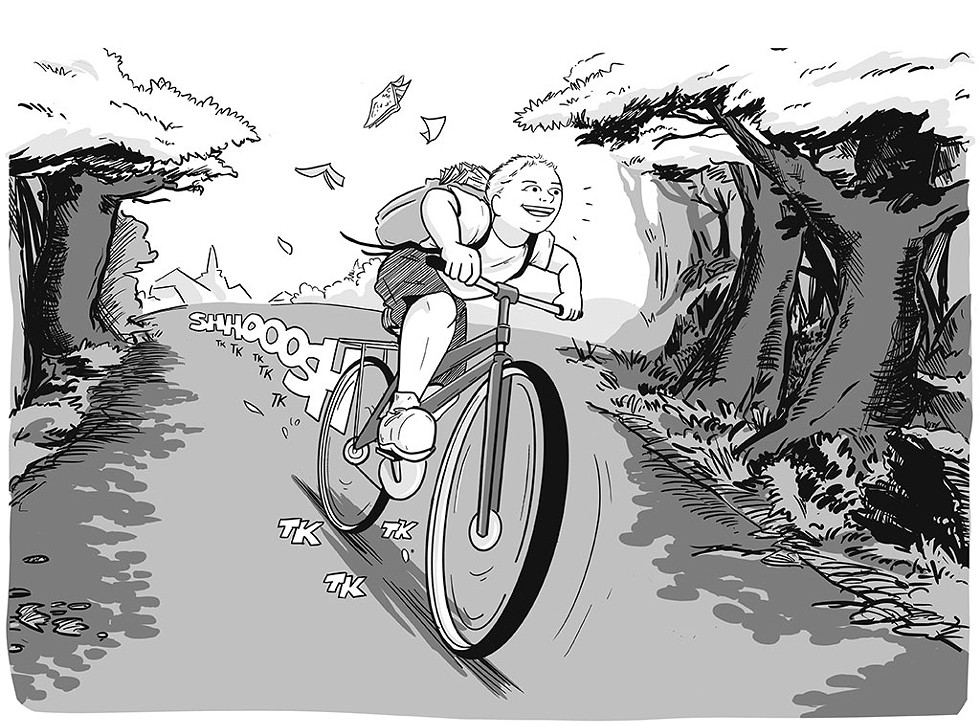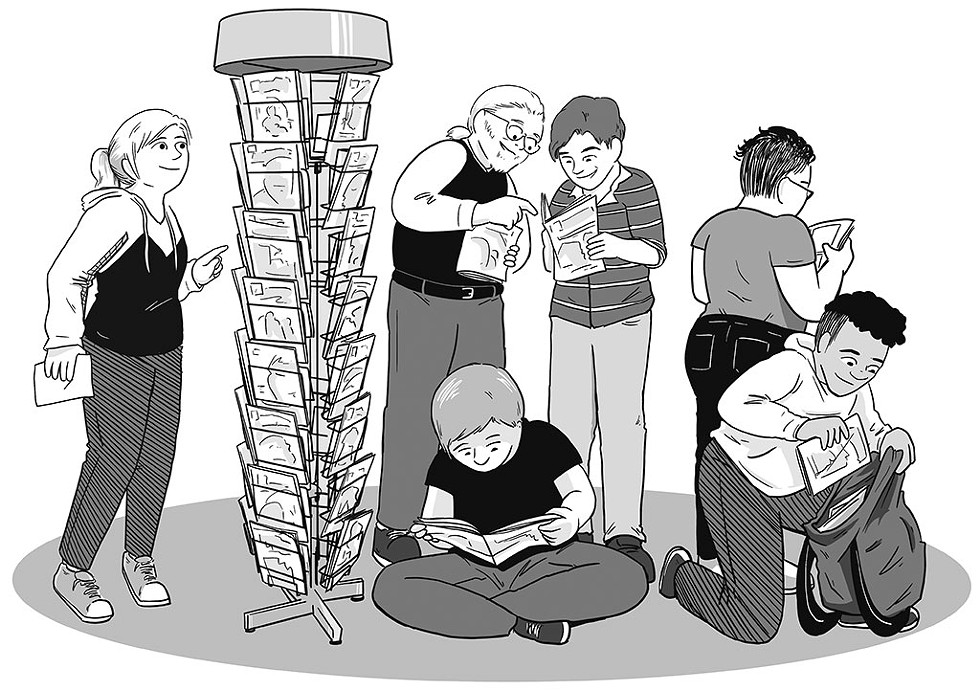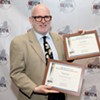Switch to the mobile version of this page.
Vermont's Independent Voice
- News
- Arts+Culture
- Home+Design
- Food
- Cannabis
- Music
- On Screen
- Events
- Jobs
- Obituaries
- Classifieds
- Personals
Browse News
Departments
-
News

UVM Cancels Commencement Speaker Amid Pro-Palestinian Protest
-
Education

Education Bill Would Speed up Secretary Search…
-
News

Middlebury College President Patton to Step Down…
- Overdose-Prevention Site Bill Advances in the Vermont Senate News 0
- 'We're Leaving': Winooski's Bargain Real Estate Attracted a Diverse Group of Residents for Years. Now They're Being Squeezed Out. Housing Crisis 0
- Aggressive Behavior, Increased Drug Use at Burlington's Downtown Library Prompt Calls for Help City 0
Browse Arts + Culture
View All
local resources
Browse Food + Drink
View All
Browse Cannabis
View All
-
Culture

'Cannasations' Podcaster Kris Brown Aims to 'Humanize'…
-
True 802

A Burlington Cannabis Shop Plans to Host…
-
Business

Judge Tosses Burlington Cannabiz Owner's Lawsuit
-
Health + Fitness

Vermont's Cannabis Nurse Hotline Answers Health Questions…
-
Business

Waterbury Couple Buy Rare Vermont Cannabis License
Browse Music
View All
Browse On Screen
Browse Events
Browse Classifieds
Browse Personals
-

If you're looking for "I Spys," dating or LTRs, this is your scene.
View Profiles
Special Reports
Pubs+More
Origin Story: How Burlington’s Earth Prime Comics Helped Unite Vermont’s Comics Lovers
Published March 2, 2022 at 10:00 a.m. | Updated July 28, 2022 at 10:32 a.m.

- Rick Veitch
I was 10 years old, staring at a strange house on Bank Street.
It was late summer, and my mother was inside the Burlington Square Mall shopping, so my brother Pat and I were cut loose to investigate the comic book shop across the street. Shadows from the trees in the yard cast the house in a mysterious darkness, making it resemble some Jungian archetype of a cave.
Pat and I were no rubes, despite our ages — Pat was 9. We'd been to the comic shops in New York City. We had a growing collection of X-Men and The New Mutants comics inherited from family friends. Hell, we had the Longshot miniseries, something we were rather proud of — and continue to be 30 years later.
Still, the house didn't look like a comic shop, and we climbed the porch stairs with trepidation. We'd only been Vermonters for a little while, and when you're the new kids in town, caution is a defense against disappointment.
I heard Pat gasp and followed his gaze to a poster taped inside the window. Staring out was the ferocious visage of Wolverine, leaping at us with adamantium claws drawn. Our hero.
This was the late 1980s, more than a decade before Hugh Jackman's Wolverine and the rest of the X-Men ushered in the age of superhero films dominating multiplexes. Back then, you wrote letters by hand to the publishers of comic books — and sometimes they answered. Comics fandom in the '80s was a club, and Pat and I were pledges standing before the clubhouse.
Steeling our nerves, we entered the store and breathed in the smell of newsprint and cardboard, the telltale musk of a good comic shop. Posters on the walls depicted more of our favorite characters, alongside many we had yet to discover. The mystery of these strange heroes and villains filled us with tension, a curiosity that had to be satiated.
But the real treat was the comics themselves. Even before we got to see the back-issue room, we salivated over the sheer number of books on display.
A bearded, longhaired man with a knowing grin looked at the two kids who'd wandered in with wide eyes.
"Well," I remember him saying, almost smugly, "looks like you found your place."
Our place, as the shopkeeper called it, was Earth Prime Comics. One of Vermont's first comic book shops, Earth Prime has been a center of the state's comic community since it moved out of original co-owner John Young's attic and into that Bank Street house-turned-shop in 1983. The shop has remained a polestar in its current home on the bottom block of the Church Street Marketplace, where it moved in 1989.
"Not many places downtown have been around longer," said Bill Simmon, who managed Earth Prime from 1989 to 1998. "Old Gold, Pure Pop, maybe a few others? You can count them on one hand, I bet. Earth Prime is an institution."
In its 39 years, Earth Prime has fostered generations of local comic fans, helping some of them go on to become comic artists themselves. The store has survived and thrived through the excitement of the underground comics explosion in the '80s, through the crisis and near collapse of the industry in the '90s — all the way to the modern epoch when movies and shows based on Marvel and DC Comics monopolize pop culture and, some say, draw interest away from their source material.
The little shop on Church Street is driven by the passion of its mysterious proprietor, Christine Farrell, who is rumored to have one of the largest and oldest private collections of comics on the planet. While Sen. Patrick Leahy (D-Vt.) may be Vermont's most famous Batman fan, she's said to have been collecting Bruce Wayne's exploits from the very beginning.
Farrell's store has been as much a clubhouse for the comic community to celebrate groundbreaking independent creators as a place to pick up the latest issue of Iron Man. It's no longer the only comic store in Vermont — many have come and gone over the decades, and the state is currently home to Barre's Wonder Cards and Comics and Rutland's newly opened Night Legion Comics. But Earth Prime has a special status for veterans of the scene.
"I have to give all due respect and honor to Earth Prime," Stephen Bissette said. The Duxbury native is one of Vermont's most influential and respected comic artists, having established himself with a seminal run in the early 1980s on Saga of the Swamp Thing with Alan Moore. He has taught for 15 years at the Center for Cartoon Studies in White River Junction.
Earth Prime has "outlived every Vermont comic shop I've ever been to," Bissette said. "Long may that continue."
The Silver Age
When Bissette was young, riding his bike from pharmacies to bookstores, hunting the comic racks for new issues, the idea of a comic book shop in Vermont seemed absurd. Born in 1955, Bissette grew up in a society that viewed comic books with suspicion, if not outright contempt and fear.
In 1954, German American psychiatrist and author Fredric Wertham published Seduction of the Innocent, in which he suggested that violent imagery, sex and crime in comic books warped young minds and put kids on a path to delinquency. Furor over the book led to U.S. Senate subcommittee hearings, which resulted in the establishment of the Comics Code Authority.
The "Comics Code," as it was called, was created by the Comics Magazine Association of America in 1954 as a means of avoiding governmental regulation. Publishers would submit comics to the CCA for its seal of approval, which attested that they'd followed such rules as "If crime is depicted it shall be as a sordid and unpleasant activity," "All lurid, unsavory, gruesome illustrations shall be eliminated" and "Females shall be drawn realistically without exaggeration of any physical qualities." Books that passed received a CCA stamp on their covers.
"It was censorship," Bissette said of the Comics Code, which didn't fall out of favor until the early 2000s.
"That's when I started getting phone calls from parents asking me to teach their kids to draw," Bissette recalled. "Why? Because we finally outlived the generation of the 1950s, who had so stigmatized comics."
Less than two hours away from where Bissette grew up, another aspiring artist was blazing a path toward a future in comics. Much like Bissette, Rick Veitch loved pulling comics from the racks of his local haunts — particularly the work of his favorite artists, Jack Kirby (Fantastic Four) and Steve Ditko (The Amazing Spider-Man).
"There wasn't much support to be an artist in Bellows Falls," Veitch said by phone from his home in West Townshend. "I was always up against some adult waving their finger at me and saying, 'You're an artist, but you can't make a living at it!'"
Veitch proved them wrong with a glittering career in comics. He followed Bissette on Moore's Swamp Thing run, then worked with that British writer — best known for Watchmen — on his seminal Miracleman series. Now 70, Veitch has moved in and out of the mainstream and the underground, leaving his indelible style on a wide variety of books.
Along the way, he and Bissette became close friends, collaborating on books such as the graphic novel adaptation of Steven Spielberg's 1941 and the 1993 series 1963 with Moore. But, perhaps because there was no hub for comic fans in Vermont at the time, the two knew nothing of each other growing up in the Green Mountains.
Veitch and Bissette didn't meet until they were both students at the Joe Kubert School of Cartoon and Graphic Art (now the Kubert School) in Dover, N.J. They graduated with the school's very first class in 1978.
"Part of that is the regionalism of the state, especially back then," Bissette said, explaining how he and Veitch never crossed paths as kids. "In the '60s and '70s, unless you were in sports or band, you weren't going to meet a kid from another school."
Bissette noted that, at roughly the same time he was in school, future comic legend Frank Miller (Sin City, 300) was attending U-32 High School in East Montpelier. One of Miller's teachers was political cartoonist and author Jeff Danziger.
Veitch said, laughing, "That's Vermont for you."
Outcast by society and without a place to gather, Bissette, Veitch, Miller and a generation of comic lovers in Vermont pursued their passion largely in isolation. But the times were changing, and help was on the way.
Misfits Assemble
Greg Giordano's mother had agreed to drive him around southern Vermont, though they didn't really know where they were going. It was the summer of 1978, and they had moved to Burlington from Long Island, N.Y., so much of the state was a mystery to them.
Giordano had seen ads in Marvel books promising a treasure trove of comics somewhere in the wilds of Vermont, but all he had was a P.O. Box and a name — Moondance Comics.
After hours of driving, they found a dirt road and a cardboard sign marked with an arrow and a roughly scrawled word: Moondance.
When they arrived, Giordano was disappointed to learn that Moondance was not a comic store but a distributor. He had essentially found the warehouse. Though the employees at Moondance were nice enough to let him buy some comics, he couldn't help feeling like he'd chased a mirage.
"I'd never seen a comic book store," Giordano recalled. "I'd heard about them from ads, but it was more of a rumored thing. As a kid, you felt like you'd never see one."
In those days, fans had one tried-and-true method for finding comics: scour the newsstands for comic racks.
Giordano's mom stayed vigilant, though. One day she found a tiny classified ad in the Burlington Free Press that promised "new comics for sale" at a Buell Street address.
Mother and son drove downtown, found the house and parked. Here they found even less signage than at Moondance. It was just a house — albeit a big one with an attic that its owner had turned into a miniature comic shop.
"The door looked like a broom closet door," Giordano recalled. "You would walk in, and it was coffin size. Plus, it was the middle of summer and hot as all hell."
Giordano squeezed into the narrow attic and found the makings of his first comic shop. There were boxes of back issues on the floor and two racks of new comics. A woman sat cross-legged in the middle of the floor reading a comic, effectively blocking the way.
Unperturbed, Giordano approached the owner of the house, a fellow comic enthusiast named John Young. The older man endeared himself to Giordano immediately.
"I'm in sixth grade with no friends yet," Giordano explained. "I'm fat and fatherless. Here comes this big guy who is friendly, has that favorite-English-teacher vibe and loves comics.
"So I was like, You're my dad now. You're my uncle," Giordano continued. "He just immediately became that male figure for me."
The woman sitting on the ground turned out to be Christine Farrell. Several months after Giordano's first visit, on February 11, 1983, she and Young took the comics out of the attic and opened the first Earth Prime Comics on Bank Street. By then, Giordano was a regular, coming to the shop every day after school.
There the formerly friendless new kid in town would meet one of his closest friends — Bill Simmon, who had also just moved to Vermont with his mother. He, too, was on the hunt for a comic store, having picked up The Amazing Spider-Man when he lived in Ithaca, N.Y.
"I walked over to the store on a Friday," Simmon said, recalling his first visit to Earth Prime. "I remember because on Fridays we would all order Bove's and eat together. I met Greg and John and Christine and Mark Amidon there. I sort of slotted right in with them and became an instant regular."
Now a documentary filmmaker, Simmon would go on to manage the shop for nearly a decade. At that time in his and Giordano's lives, he said, they needed a place like Earth Prime as a haven — not only to talk about comics but also to meet like-minded people and form social bonds.
Mark Amidon was a different story. Born and raised in Burlington, he was older than the kids the store pulled into its orbit, with a college degree and a job as an engineer at IBM. He sought out Earth Prime and reentered the world of comics, which he had stopped reading some years back.
Giordano described Amidon as "a total nerd from Planet Nerd," a tall, longhaired and bearded guy who wore paisley ties and hats covered in buttons. He was also somehow incongruously cool.
"He was like one of the characters in Real Genius," Giordano said, referencing the 1985 Val Kilmer film about a motley crew of nerds. "But he knew his wine; he knew his dope; he had a girlfriend. He just loved comics and the vibe at Earth Prime so much that he would come hang out after he got off work every day."
Amidon left IBM and Vermont in 1988 and settled in Massachusetts, where he still lives. But for five years, he helped form the core of the initial Earth Prime crew.
Hanging out and volunteering at the store "expanded my own comic horizons massively," Amidon said by phone. "There were so many incredible indie books, British imports, all this cool stuff at the store. I moved away from the mainstream books and sort of became the store expert on the less well-known stuff. John and Christine were working on finances and all that, while I was reading every bloody comic that came in."
The Collector
Amidon, Simmon and Giordano all described a family dynamic at the Bank Street incarnation of Earth Prime — perhaps, in part, because it was in a house. The front parlor was the shop. The back issues were in a guest room, and the office was in the master bedroom. In the fully functioning kitchen, Giordano often cooked the staff French toast before the store opened on Saturdays.
Earth Prime's arrival changed things for Vermont comic fans almost immediately. No longer did they have to haunt newsstands, pharmacies and bookshops in hopes of finding the books they wanted. And Earth Prime had something those other retailers didn't: back issues.
Both Young and Farrell had massive collections, but they weren't interested in selling them, according to Amidon. Buying was a different matter. One day, an older man who had been collecting Marvel comic books since the early '70s showed up with a few thousand, eager to unload them so he could buy himself a new car.
"He had everything," Amidon recalled. "Uncanny X-Men, Iron Man, Fantastic Four ... all of those classic Marvel titles. He didn't read them anymore; he just wanted to buy a car and keep his Conan books, which for some reason he kept pronouncing as 'Co-han.'"
Farrell and Amidon gave it to the man straight: They would offer him 40 percent of the retail value of the books and sell them for much more. The man wasn't deterred, according to Amidon.
So Amidon, Farrell and Young pulled out the Overstreet Guide to Grading Comics, learned how to assess comics on the spot and bought the man's massive inventory. Suddenly the store had a new section.
One has to wonder how Farrell, herself a passionate collector, felt seeing that seller give up his comics. While her employees, past and present, couldn't confirm, most of them agreed that Farrell has one of the largest private collections of golden-age DC books in the world.
Through current Earth Prime manager Damon Savage, Seven Days arranged to meet Farrell in person for an interview at the now-closed Heroes Kingdom, a collectibles and gaming shop she once owned in St. Albans. But Farrell didn't show up, nor did she respond to several phone calls, emails and a letter — everything short of the Bat-Signal — to be interviewed for this story. That's par for the course these days, according to those who know her.
"She's like a ghost to the people in the comics community now," Giordano said of Farrell. "No one really knows her anymore, but back then, guys always underestimated her commitment as a fan. And it was purely sexist, obviously."
Farrell's family founded Farrell Distributing in 1933 and incorporated it 30 years later; the company still ships beverages to retailers all over Vermont. Growing up in Burlington, Farrell started buying comics at age 10, she would later tell Derek Muirden of Mountain Lake PBS. Her favorites tended to be female-fronted books such as Lois Lane and the "Supergirl" strip in Action Comics. Perhaps those characters reminded her of herself, advocating for herself in a male-dominated field that's notoriously unkind to women.
Though Giordano has lost contact with Farrell, he recalls hearing about her comic collection.
"Other than a few crazy-rare, who-knows-if-they-even-exist kind of books," he said, "my understanding was that Christine had every issue of all the early, golden- and silver-age DC stuff."
Serious collectors would give an eye for an entire run of Batman in Detective Comics, not to mention Superman, Wonder Woman and Green Lantern's maiden runs.
The value of those comics alone would be staggering, let alone the entire DC canon from 1938 to 1970. Surely Giordano didn't mean all of them?
"All of them," Giordano said with a wry grin.
If Farrell's collection is shrouded in mystery, that could be because she wants to avoid the fate of Brattleboro collector Jim Wheelock, whose massive collection of rare and vintage comics was stolen in 2015 and never recovered.
Still, there is some documentation of her treasures. The acknowledgments in some DC Comics collections indicate that, on occasion, Farrell has let the publisher make copies of her comics for reprints and posterity. (Owned by Warner Bros. since 1969, DC famously kept poor records of its golden-age books.) In the mid-'90s, Farrell allowed author Ernst Gerber to photograph her vast collection of golden- and silver-age comics for The Photo-Journal Guide to Comic Books. The two-volume book is one of the most comprehensive studies of the art form available, documenting more than 20,000 comic covers.
In a 1995 episode of a Mountain Lake PBS program called "People Near Here," host Muirden follows Farrell into her office, where she stored much of her collection at the time. The floor is covered in long white comic boxes, which also line the walls like alabaster library shelves. Original pencil-and-ink art of Superman from an issue of Action Comics is framed on the wall.
"This is my childhood, or at least a significant portion of it," Farrell says, smiling nervously as Muirden picks through some of the comics. Clearly, she was unaccustomed to welcoming visitors into her sanctum sanctorum.
Muirden finds a copy of Detective Comics from early 1939.
"Batman started in No. 27," Farrell says with a note of pride. "That one is pre-Bat."
Muirden pulls a copy of Flippity and Flop, an adaptation of animated shorts from the late '40s starring a cat and a canary, out of an old Arrow shirt box. Farrell shrugs almost sheepishly.
"I buy them because I want to read them. I wanted them so I could look at them," she says. "But not for resale, not at all. I do not intend to sell the collection. That's not what I'm in it for."
When Muirden asks how many comics she actually owns, Farrell laughs as if brushing off the question.
"It's been a long, long time since I've counted," she says. "I lost count somewhere around 12,000. And I'm still at it. Can't give up; it's an addiction."
It Came From the Underground
Earth Prime's arrival in the '80s was perfectly timed, as the world of comics was undergoing a revolution on the national stage. Meanwhile, in Vermont, the store united a ragtag crew of comic fans into a community.
"I find, with people like us, it's inevitable, right?" said John Odum, who hosts a podcast about all things geek called "Open World Chat." "It's part of being a comic fan. Eventually, we all start finding each other. It's just a question of where."
Odum is the Montpelier city clerk and a freelance writer for comics sites such as Bleeding Cool. He grew up during the independent comics revolution of the '80s, when artists like Bissette and Veitch started pushing back against the censorship of their youth, working with writers far removed from the kid-friendly scripts of Stan Lee.
Moore's Watchmen series and Miller's dark, noir-tinged work on Batman and Daredevil changed the mainstream superhero books. The arrival of titles such as Cerebus and Elfquest marked the rise of the underground.
"The 1980s changed comics," Odum said.
Veitch agrees.
"The '80s for comics were like the '60s for music," he said. "For a short time, before the moneymen caught on, the inmates got control of the asylum."
Earth Prime was at the forefront of that movement in Vermont. Its reputation drew fans from all over the state.
One such customer was John Rovnak. Much like Giordano, he had a mother who was supportive of his comics passion and drove him the two and a half hours to Earth Prime once a month.
Rovnak, who now lives in Essex, recalled his first visit to the store in 1986. "It was the coolest place in the world to me," he said. "It smelled like newsprint, and all these people were hanging out talking about comics I'd never even heard of."
Rovnak opened his own comic shop in Manchester, Comics Route, in 1992, inspired by those trips to Burlington and a selection more diverse than he had ever encountered. Earth Prime had its Wolverine and Batman posters, pulling in kids like my brother and me. Once inside, though, customers discovered pathways to many other stories.
"Let's give Christine full credit for curating that store," Amidon said. "She kept track of every book and how it sold, which ones were picking up in popularity and which ones weren't. Just because any of us thought a book was good didn't mean it would sell, and she knew that."
Farrell even kept track of when popular artists or writers would be leaving a series, so as to be prepared for lower sales.
"She and John listened to us when we found something exciting, too," Giordano said. "If we saw an underground book we thought would be amazing, they would often carry it."
By 1985, Giordano began hosting comic conventions in Burlington, using the skills and industry connections he had gained working at Earth Prime. A newsprint ad from the Burlington Free Press advertised the second annual Green Mountain Comic Con, held at the Windjammer in Williston. Bissette, who also did some of the first signings at Earth Prime, was a guest, as was Gaijin creator Gabriel Morrisette.
The convention also featured two little-known creators whom Giordano was bullish on.
"I had seen these two guys at another con, and they had this really cool but sort of raw book they were working on," Giordano said. "It was black and white, and they told me their uncle had given them a loan to finish it. It was the craziest thing I'd heard of at that point — the Teenage Mutant Ninja Turtles? Like, what the fuck?"
Giordano was charmed by the team of martial arts-equipped turtles, who kicked evil ninja ass and listened to Metallica while they skateboarded. Soon they would be a household name.
"I'm not some genius, but I know when something like that is going to be huge," he said. "I practically ran back and begged John and Christine to buy the book to sell at Earth Prime."
Farrell's self-described "pack rat" nature pushed her toward indie comics, as well. She had learned long ago that the mainstream superhero books weren't enough to satiate her collecting desires.
"I got into collecting miscellaneous," she tells Muirden in the PBS interview. "I collect the love comics, the humor stuff, the war stuff ... It requires a lot of patience. I guess it was the completist in me that branched out from the superheroes."
The store's dedication to the alternative press got some pushback. The 1980s saw a rebirth of conservative alarmism about comics with president Ronald Reagan, reverend Jerry Falwell and his so-called Moral Majority.
"At the time, there was also this mini-boom of sexually explicit comics that I called the 'smut glut,'" Amidon recalled with a chuckle. "They were usually these black-and-white things, sometimes drawn in the style of Archie comics. Basically, yeah, porn."
Earth Prime staff made an early decision to remove those books from the general stacks, along with more adult fare such as Heavy Metal magazine, and create an adults-only section in another room of the store.
It was a timely move. Soon after, Amidon was working when a trio of older men, all wearing business suits with cross pins on their lapels, came into the shop. He recalled that one had a pin emblazoned with the words "Whatever It Takes."
They told Amidon that they had heard there were comics that were inappropriate for children.
Smiling widely, the picture of customer service, Amidon responded, "Yes, there are. We carry them here, as a matter of fact."
The three would-be inquisitors demanded to see the offending comics, their eyes alight with coming indignation. Amidon explained that if they wanted to see the books, they would have to show some ID, as the section was off-limits to minors.
"We don't censor what adults want to read," Amidon explained. "But we know these books aren't for kids; we don't even let them browse the section."
Their fervor dampened by Amidon's amiability, the crusaders left the store. Each carried a copy of The Fabulous Furry Freak Brothers, an underground comic about the misadventures of three Texas stoners and their constant quest to score drugs.
"Not a bad day's work, if I do say so myself," Amidon said.
Don't Call It a Comeback
As the 1980s wound up, the scene changed at Earth Prime. Amidon left for Massachusetts. Many of the first-generation Earth Prime kids grew up and either moved away, as Pat and I did in 1989, or simply lacked the time they once had to hang out at the shop all day.
"The family atmosphere kind of changed," Simmon said. "It was still fun to be there and talk comics, but look, we weren't kids anymore. Life tends to get more serious, even at comic shops."
In the spring of 1989, Farrell bought out Young's half of the business and moved Earth Prime to its current spot at 152 Church Street. Though none of the original gang wanted to go into details, they implied that some sort of schism occurred between the two founders of Earth Prime. Young opened Comics City at the other end of downtown Burlington, before moving eventually to Winooski. Customers were split; many, like Rovnak, switched over to Young's new store.
Within a few years, the entire comics industry was rocked like never before, as its own increasing cultural legitimacy sent it into a boom-and-bust cycle. Collectors started snapping up "big event" books such as The Death of Superman and Batman: Knightfall, creating a bloat in the speculator market that coincided with a disastrous decision by Marvel to bypass the distributors and form its own distribution wing. When the market crashed, the company was stuck with multiple printings of variant issues that were meant to be "collectible" but are now the exact opposite.
Marvel declared bankruptcy in 1997, and an estimated two-thirds of all comic shops shuttered their doors. Rovnak's shop in Manchester closed in 1998, Young's Comics City in 1998. Independent publishers like Veitch saw their imprints disappear.
"Per usual, the business guys screwed it all up," Veitch said with a snicker. "They tried to control the distribution system and screw the little guys. Well, it worked, but they screwed themselves, too."
"I heard that Earth Prime ended up bouncing back in the early 2000s," said Simmon, who rarely visits the store these days. "But in my last few years there, we weren't really financially solvent anymore."
What kept Earth Prime afloat while all the other boats sank? Farrell herself seems to have been a major factor. Her clear vision of how to create communities of like-minded fans would serve her well, as one industry faltered and another emerged.
In 1989, Farrell opened Quarterstaff Games directly above Earth Prime. With its medieval-tavern vibe, it's Vermont's longest-lived gaming shop. Like its sister store, Quarterstaff has fostered a long-marginalized community and given them a home — another tribute to Farrell's dedication.
Farrell's tenacity was rewarded as the century came to a close and the fortunes of comics changed once again. Though superheroes had made their mark on cinema in the past, notably with Tim Burton's Batman and Richard Donner's Superman films, the 2000s saw the rise of Marvel as an entertainment business. In 20 years, the company went from barely surviving bankruptcy to being a multibillion-dollar juggernaut that dominates Hollywood. Disney would buy it in 2009.
For a 2001 story about Earth Prime, Seven Days interviewed the store's then-comanagers, Jason Andreasson and John Pepe. They expressed high spirits as the spandex set began its Tinseltown takeover.
"Comics are really entering their heyday," Andreasson said.
Time has proved him correct, though perhaps not quite in the way he foresaw. Yes, superhero stories have become a financial monster, making once-obscure Marvel and DC characters familiar to the masses. But the effect on the comics industry itself is harder to gauge.
"Honestly, the superhero stuff doesn't sell anything like it used to," said current Earth Prime manager Damon Savage, who has been at the store for more than 13 years. "The correlation between Hollywood success and selling comics isn't really there like one might think."
That development doesn't surprise James Sturm, a cartoonist who cofounded Vermont's Center for Cartoon Studies and the Seattle-based alt-weekly the Stranger. Sturm thinks that the movies have changed what people want out of their comic books.
"When I was a kid, if you saw someone in the movies fly or shoot lasers from their eyes, it always looked cheesy," he said. "But when you would read that in X-Men, it looked awesome; it looked right. Well, now the movies can do that, and so can the video games. Better, even."
Where does that leave comics? In a place of unfettered potential, according to Kristen Shull, a Burlington-based graduate of CCS who writes a daily diary comic strip and teaches sequential art at Champlain College.
"Comics as a medium is so multifaceted," Shull said. "And something about Vermont seems to encapsulate just about all of [the possibilities]. We've got people doing the superhero thing; we've got people doing manga, doing memoir and educational stuff..."
Citing acclaimed comic artists such as Alison Bechdel of Bolton, she added, "The art form has been legitimized."
Rovnak echoed that sentiment. When he was young, the idea of reading one of his favorite comics on the bus was laughable — or, as he put it, "a quick way to get punched in the face by a jock."
"When I see kids on Church Street reading comics, I think, My God, how are they so brave?" Rovnak wondered with a laugh. "But at this point, we're all coming out of the shadows and finding our tribes. Comics went from something you do alone to being a social thing."
For Giordano, that process started at Earth Prime, where the future illustrator would draw all day at a table beside the back issues.
"I would never have become an artist if I didn't have somewhere like Earth Prime," he said. "People there would see me drawing, whether it was coworkers or customers, and gave me positive feedback. There's power in that — I started to think, Hey, maybe I'm not a total piece of shit. Maybe I have some value. I owe everything to that experience."
To Be Continued
I remembered Giordano's words as I stared down the front door of Earth Prime a few weeks ago. I hadn't been inside in years, but knowing that the store was there hung on me like a weight, like a gift I couldn't dare take for granted.
I walked inside, unsurprised by the posters this time. The staff were helping customers or reading comics as hip-hop played softly over the speakers.
I thought of Shady, the black cat who used to guard the boxes of comics with a lazy swipe of her paw. I thought about how I've skipped every school reunion I've ever been invited to and how none of them would have felt as much like an authentic reunion as being inside Earth Prime did at that moment.
A man roughly my own age walked in, flanked by several children. One of them, a young girl wearing a white-and-pink Spider-Gwen hoodie, had a list in hand. She bounced on the balls of her feet as she browsed from shelf to shelf, humming quietly.
I looked away, overcome by a rogue wave of emotion. I seemed to see a thread stretching back through time, connecting Bissette, Veitch and Farrell hunting the comics racks to misfits like Giordano and Simmon finding family at a fledgling shop. That thread reached all the way to the girl in the hoodie, humming to herself in her happy place. Earth Prime was hers now more than mine, and I loved that so much that I felt a strange, damp sensation at the corners of my eyes.
As I walked away from Earth Prime, I made a mental note to text my brother. I wanted to say something reflective of the strange epiphany I'd had standing in the shop. In the end, though, I decided to keep it simple.
"Dropped by Earth Prime," I texted Pat. "Still the same."
Got something to say?
Send a letter to the editor
and we'll publish your feedback in print!
Tags: Comics, Burlington, Earth Prime, comics, comic books, cartoons, Earth Prime Comics
About The Author

Chris Farnsworth
Bio:
Music editor Chris Farnsworth has written countless albums reviews and features on Vermont's best musicians, and has seen more shows than is medically advisable. He's played in multiple bands over decades in the local scene and is a recording artist in his own right. He can often be found searching for the perfect soft pretzel or listening to a podcast about the X-Men.
Music editor Chris Farnsworth has written countless albums reviews and features on Vermont's best musicians, and has seen more shows than is medically advisable. He's played in multiple bands over decades in the local scene and is a recording artist in his own right. He can often be found searching for the perfect soft pretzel or listening to a podcast about the X-Men.
More By This Author
Latest in Comics
Related Locations
-
Earth Prime Comics
- 154 Church St., Burlington Burlington VT 05401
- 44.47613;-73.21229
-
 802-863-3666
802-863-3666
Related Stories
Speaking of...
-

Overdose-Prevention Site Bill Advances in the Vermont Senate
May 1, 2024 -

Aggressive Behavior, Increased Drug Use at Burlington's Downtown Library Prompt Calls for Help
May 1, 2024 -

Reinvented Deep City Brings Penny Cluse Café's Beloved Brunch Back to Burlington
Apr 30, 2024 -

Burlington’s Blue Cat Steak & Wine Bar Closes After 18 Years
Apr 30, 2024 -

Burlington Budget Deficit Balloons to $13.1 Million
Apr 25, 2024 - More »







































find, follow, fan us: